Prediction of Favourable Hydrocarbon Transport Pathways of the Jiuzhou Fault in Langgu Sag, Bohai Bay Basin
Abstract
1. Introduction
2. Geological Settings
3. Influencing Factors of the Locations of Favourable Transport Pathways
3.1. Location of Paleo Relay Ramps before Hydrocarbon Accumulation
3.2. Fault Activity Intensity during Hydrocarbon Accumulation
3.3. Hydrocarbon Transport Ridges of Faults
4. Method for Predicting the Location of Favourable Hydrocarbon Transport Pathways
4.1. Recognition of Relay Ramps Developed before Hydrocarbon Accumulation
4.2. Determination of Fault Activity Intensity during Hydrocarbon Accumulation
4.3. Determination of the Location of Transport Ridges
5. Prediction of the Location of Favourable Hydrocarbon Transport Pathways
6. Results and Discussion
Author Contributions
Funding
Institutional Review Board Statement
Informed Consent Statement
Data Availability Statement
Acknowledgments
Conflicts of Interest
Correction Statement
References
- Price, L.C. Basin richness and source rock disruption: A fundamental relationship. J. Petrol. Geol. 1994, 17, 5–38. [Google Scholar] [CrossRef]
- Hindle, A.D. Petroleum migration pathways and charge concentration: A three-dimensional model. AAPG Bull. 1997, 81, 1451–1481. [Google Scholar]
- Williams, R.T.; Beard, B.L.; Goodwin, L.B.; Sharp, W.D.; Johnson, C.M.; Mozley, P.S. Radiogenic isotopes record a ‘drop in a bucket’–A fingerprint of multi-kilometer-scale fluid pathways inferred to drive fault-valve behavior. J. Struct. Geol. 2019, 125, 262–269. [Google Scholar]
- Caine, J.S.; Evans, J.P.; Forster, C.B. Fault zone architecture and permeability structure. Geology 1996, 24, 1025–1028. [Google Scholar] [CrossRef]
- Fu, X.; Xu, P.; Wei, C.; Lv, Y. Internal structure of normal fault zone and hydrocarbon migration and conservation. Earth Sci. Front. 2012, 19, 200–212. [Google Scholar]
- Bauer, J.F.; Meier, S.; Philipp, S.L. Architecture, fracture system, mechanical properties and permeability structure of a fault zone in Lower Triassic sandstone, Upper Rhine Graben. Tectonophysics 2015, 647–648, 132–145. [Google Scholar] [CrossRef]
- Medina-Cascales, I.; Koch, L.; Cardozo, N.; Martin-Rojas, I.; Alfaro, P.; García-Tortosa, F.J. 3D geometry and architecture of a normal fault zone in poorly lithified sediments: A trench study on a strand of the Baza Fault, central Betic Cordillera, south Spain. J. Struct. Geol. 2019, 121, 25–45. [Google Scholar] [CrossRef]
- Delogkos, E.; Manzocchi, T.; Childs, C.; Camanni, G.; Roche, V. The 3D structure of a normal fault from multiple outcrop observations. J. Struct. Geol. 2020, 136, 104009. [Google Scholar] [CrossRef]
- Xie, X.; Li, S.; Dong, W.; Hu, Z. Evidence for episodic expulsion of hot fluids along faults near diapiric structures of the Yinggehai Basin, South China Sea. Mar. Petrol. Geol. 2001, 18, 715–728. [Google Scholar] [CrossRef]
- Yielding, G.; Freeman, B.; Needham, D.T. Quantitative fault seal prediction. AAPG Bull. 1997, 81, 897–917. [Google Scholar]
- Lyu, Y.; Wang, W.; Hu, X.; Fu, G.; Shi, J.; Wang, C.; Liu, Z.; Jiang, W. Quantitative evaluation method of fault lateral sealing. Petrol. Explor. Dev. 2016, 43, 310–316. [Google Scholar] [CrossRef]
- Chester, F.M.; Logan, J.M. Implications for mechanical properties of brittle faults from observations of the Punchbowl fault zone, California. Pure Appl. Geophys. 1986, 124, 79–106. [Google Scholar] [CrossRef]
- Forster, C.B.; Evans, J.P. Hydrogeology of thrust faults and crystalline thrust sheets: Results of combined field and modeling stud-ies. Geophys. Res. Lett. 1991, 18, 979–982. [Google Scholar] [CrossRef]
- Chester, F.M.; Evans, J.P.; Biegel, R.L. Internal structure and weakening mechanisms of the San Andreas Fault. J. Geophys. Res. Solid Earth 1993, 98, 771–786. [Google Scholar] [CrossRef]
- Pei, Y.W.; Knipe, R.J.; Paton, D.A.; Douglas, A.; Wu, K. A review of fault sealing behaviour and its evaluation in siliciclastic rocks. Earth-Sci. Rev. 2015, 150, 121–138. [Google Scholar] [CrossRef]
- Kim, S.; Ree, J.H.; Han, R.; Kim, N.; Jung, H. Fabric transition with dislocation creep of a carbonate fault zone in the brittle regime. Tectonophysics 2018, 723, 107–116. [Google Scholar] [CrossRef]
- Knipe, R.J.; Jones, G.; Fisher, Q.J. Faulting, fault sealing and fluid flow in hydrocarbon reservoirs: An introduction. J. Petrol. Sci. Eng. 1998, 25, 93. [Google Scholar] [CrossRef]
- Kim, Y.S.; Peacock, D.C.P.; Sanderson, D.J. Fault damage zones. J. Struct. Geol. 2004, 26, 503–517. [Google Scholar] [CrossRef]
- Schueller, S.; Braathen, A.; Fossen, H.; Tveranger, J. Spatial distribution of deformation bands in damage zones of extensional faults in porous sandstones: Statistical analysis of field data. J. Struct. Geol. 2013, 52, 148–162. [Google Scholar] [CrossRef]
- Gomila, R.; Arancibia, G.; Mitchell, T.M.; Cembrano, J.M.; Faulkner, D.R. Palaeopermeability structure within fault-damage zones: A snap-shot from microfrac-ture analyses in a strike-slip system. J. Struct. Geol. 2016, 83, 103–120. [Google Scholar] [CrossRef]
- Faulkner, D.R.; Lewis, A.C.; Rutter, E.H. On the internal structure and mechanics of large strike-slip fault zones: Field observations of the Carboneras fault in southeastern Spain. Tectonophysics 2003, 367, 235–251. [Google Scholar] [CrossRef]
- Childs, C.; Manzocchi, T.; Walsh, J.J.; Bonson, C.G.; Nicol, A.; Schöpfer, M.P. A geometric model of fault zone and fault rock thickness variations. J. Struct. Geol. 2009, 31, 117–127. [Google Scholar] [CrossRef]
- Flodin, E.; Aydin, A. Faults with asymmetric damage zones in sandstone, Valley of Fire State Park, southern Nevada. J. Struct. Geol. 2004, 26, 983–988. [Google Scholar] [CrossRef]
- Liu, J.; Lv, Y.; Fu, G.; Sun, T.; Li, J. Transporting Models of Oil-Gas Migration by Normal Fault and Its Controlling Effect to Oil-Gas Distribution. J. Jilin Univ. (Earth Sci. Ed.) 2016, 46, 1672–1683. [Google Scholar]
- Sibson, R.H.; Moore, J.M.M.; Rankin, A.H. Seismic pumping—A hydrothermal fluid transport mechanism. J. Geol. Soc. 1975, 131, 1081–1090. [Google Scholar] [CrossRef]
- Hooper, E.C.D. Fluid migration along growth faults in compacting sediments. J. Petrol. Geol. 1991, 14, 161–180. [Google Scholar] [CrossRef]
- Almayahi, A.; Woolery, E.W. Fault-controlled contaminant plume migration: Inferences from SH-wave reflection and electrical resis-tivity experiments. J. Appl. Geophys. 2018, 158, 57–64. [Google Scholar] [CrossRef]
- Sun, T.; Fu, G.; Lv, Y.; Zhao, R. A Discussion on Fault Conduit Fluid Mechanism and Fault Conduit Form. Geol. Rev. 2012, 58, 4308–4316. [Google Scholar]
- Gudmundsson, A. Fluid overpressure and flow in fault zones: Field measurements and models. Tectonophysics 2001, 336, 183–197. [Google Scholar] [CrossRef]
- Liu, J.; Wang, H.; Lyu, Y.; Sun, T.; Zhang, M.; He, W.; Sun, Y.; Zhang, T.; Wang, C.; Cao, L. Reservoir controlling differences between consequent faults and antithetic faults in slope area outside of source: A case study of the south-central Wenan slope of Jizhong Depression, Bohai Bay Basin, NE China. Petrol. Explor. Dev. 2018, 45, 82–92. [Google Scholar] [CrossRef]
- Eichhubl, P.; Davatzes, N.C.; Becker, S.P. Structural and diagenetic control of fluid migration and cementation along the Moab fault, Utah. AAPG Bull. 2009, 93, 653–681. [Google Scholar] [CrossRef]
- Yan, J.; Luo, X.; Wang, W.; Toussaint, R.; Schmittbuhl, J.; Vasseur, G.; Chen, F.; Yu, A.; Zhang, L. An experimental study of secondary oil migration in a three-dimensional tilted porous medium. AAPG Bull. 2012, 96, 773–788. [Google Scholar] [CrossRef]
- Vasseur, G.; Luo, X.; Yan, J.; Loggia, D.; Schmittbuhl, J. Flow regime associated with vertical secondary migration. Mar. Petrol. Geol. 2013, 45, 150–158. [Google Scholar] [CrossRef]
- Luo, X. Mathematical modeling of temperature-pressure transient variation in opening fractures and sedimentary for-mations. Oil Gas Geol. 1999, 20, 1–6. [Google Scholar]
- Zhang, L.; Luo, X.; Song, G.; Hao, X.; Qiu, G.; Song, C.; Lei, Y.; Xiang, L.; Liu, K.; Xie, Y. Quantitative evaluation of parameters to characterize fault opening and sealing during hydrocarbon migration. Acta Petrol. Sin. 2013, 34, 92–100. [Google Scholar]
- Jung, B.; Garven, G.; Boles, J.R. Effects of episodic fluid flow on hydrocarbon migration in the Newport-Inglewood Fault Zone, Southern California. Geofluids 2014, 14, 234–250. [Google Scholar] [CrossRef]
- Sun, T.; Fu, G.; Wang, F.; Zhang, L.; Xi, G.; Lv, Y. Control effect of transporting ridge in hydrocarbon accumulation in uplift area outside of source area:A case study of Fuyu oil layer in Xingbei Region, Daqing placanticline. J. Cent. South Univ. (Sci. Technol.) 2014, 45, 4308–4316. [Google Scholar]
- Zou, H.; Zhou, X.; Bao, X.; Liu, J.; Teng, C.; Zhuang, X. Controlling factors and models for hydrocarbon enrichment/depletion in Paleo-gene and Neogene, Bohai sea. Acta Petrol. Sin. 2010, 31, 885–893. [Google Scholar]
- Fu, Q.; Liu, B.; Xu, C.; Niu, C.; Fu, N.; Zhang, B.; Ding, L. The couple relationship of quantitative analysis of the structures and oil & gas accumula-tion in Huanghekou depression, Bohai Bay Basin. Acta Petrol. Sin. 2013, 34, 112–119. [Google Scholar]
- Jiang, Y.L.; Liu, P.; Song, G.Q.; Liu, H.; Wang, Y.S.; Zhao, K. Late Cenozoic faulting activities and their influence upon hydrocarbon accumulations in the Neogene in Bohai Bay Basin. Oil Gas Geol. 2015, 36, 525–533. [Google Scholar]
- Wan, G.; Tang, L.; Jin, W.; Yang, W.; Lei, G. Control of salt-related tectonics on oil and gas accumulation in the western Kuqa depression. Acta Geol. Sin. 2007, 81, 187–196. [Google Scholar]
- Zhao, X.; Jin, F.; Wang, Q.; Fan, B.; Yang, D. The Secondary Exploration Engineering of Oil-Rich Sag in Graben Basin; Petroleum Industry Press: Bejing, China, 2016; pp. 51–275. [Google Scholar]
- Scholz, C.H.; Sykes, L.R.; Aggarwal, Y.P. Earthquake prediction: A physical basis. Science 1973, 181, 803–810. [Google Scholar] [CrossRef]
- Zhao, M.; Liu, Z.; Xin, Q.; Cai, Y. Geologic factors for controlling vertical migration of hydrocarbons along faults. J. China Univ. Petrol. (Ed. Nat. Sci.) 2001, 25, 21–24. [Google Scholar]
- Wang, W.; Dou, L.; Zhang, Z.; Li, Z.; Li, Q. Transfer zone character and its relationship to hydrocarbon in Fula Sag, Sudan. Petrol. Explor. Dev. 2007, 34, 124–127. [Google Scholar]
- Schlische, R.W. Geometry and origin of fault-related folds in extensional setting. AAPG Bull. 1995, 79, 1661–1678. [Google Scholar]
- Liao, J.; Wang, H.; Lv, M.; Xiao, J.; Gan, H.; Yan, D. Evolution of syndepositional faulting and its controlling effect on sedimentary filling in Songnan-Baodao sag of Qiongdongnan basin, South China Sea. J. China Univ. Min. Technol. 2016, 45, 336–346. [Google Scholar]
- Boles, J.R.; Eichhubl, P.; Garven, G.; Chen, J. Evolution of a hydrocarbon migration pathway along basin-bounding faults: Evidence from fault cement. AAPG Bull. 2004, 88, 947–970. [Google Scholar] [CrossRef]
- Peacock, D.C.P.; Sanderson, D.J. Geometry and development of relay ramps in normal fault systems. Am. Assoc. Petrol. Geol. Bull. 1994, 78, 147–165. [Google Scholar]
- Giba, M.; Walsh, J.J.; Nicol, A. Segmentation and growth of an obliquely reactivated normal fault. J. Struct. Geol. 2012, 39, 253–267. [Google Scholar] [CrossRef]
- Childs, C.; Easton, S.J.; Vendeville, B.C.; Jackson, M.; Lin, S.T.; Walsh, J.J.; Watterson, J. Kinematic analysis of faults in a physical model of growth faulting above a viscous salt analogue. Tectonophysics 1993, 228, 313–329. [Google Scholar] [CrossRef]
- Chapman, T.J.; Meneilly, A.W. The displacement patterns associated with a reverse-reactivated, normal growth fault. Geol. Soc. Lond. Spec. Publ. 1991, 56, 183–191. [Google Scholar] [CrossRef]
- Rowan, M.G.; Hart, B.S.; Nelson, S. Three-dimensional geometry and evolution of a salt-related growth-fault array: Eugene Is-land 330 field, offshore Louisiana, Gulf of Mexico. Mar. Petrol. Geol. 1998, 17, 309–328. [Google Scholar] [CrossRef]
- Kim, Y.S.; Sanderson, D.J. The relation between displacement and length of faults:A review. Earth-Sci. Rev. 2005, 68, 317–334. [Google Scholar] [CrossRef]
- David, M.D.; Bruced, D.T. Four-dimensional analysis of the Sembo relay system, offshore Angola: Implications for fault growth in salt-detached settings. AAPG Bull. 2009, 93, 763–794. [Google Scholar]
- Wu, Z.; Li, W.; Zheng, D.; Lv, H. Analysis on Features and Origins of the Mesozoic and Cenozoic Faults in Zhanhua Sag. Geol. J. China Univ. 2004, 10, 405–417. [Google Scholar]
- Elkhoury, J.E.; Brodsky, E.E.; Agnew, D.C. Seismic waves increase permeability. Nature 2006, 441, 1135–1138. [Google Scholar] [CrossRef]
- Elkhoury, J.E.; André Niemeijer Brodsky, E.E.; Marone, C. Laboratory observations of permeability enhancement by fluid pressure oscilla-tion of in situ fractured rock. J. Geophys. Res. Solid Earth 2011, 116, B02311. [Google Scholar] [CrossRef]
- Balsamo, F.; Storti, F.; Salvini, F.; Silva, A.; Lima, C. Structural and petrophysical evolution of extensional fault zones in low-porosity, poorly lithified sandstones of the Barreiras Formation, NE Brazil. J. Struct. Geol. 2010, 32, 1806–1826. [Google Scholar] [CrossRef]
- Fossen, H.; Rotevatn, A. Fault linkage and relay structures in extensional settings—A review. Earth-Sci. Rev. 2016, 154, 14–28. [Google Scholar] [CrossRef]
- Nixon, C.; Vaagan, S.; Sanderson, D.J.; Gawthorpe, R.L. Spatial distribution of damage and strain within a normal fault relay at Kilve, U.K. J. Struct. Geol. 2019, 118, 194–209. [Google Scholar] [CrossRef]
- Kim, Y.S.; Sanderson, D.J. Inferred fluid flow through fault damage zones based on the observation of stalactites in carbonate caves. J. Struct. Geol. 2010, 32, 1305–1316. [Google Scholar] [CrossRef]
- Peiro, A.; Simón, J.L.; Román-Berdiel, T. Fault relay zones evolving through distributed longitudinal fractures: The case of the Teruel graben system (Iberian Chain, Spain). J. Struct. Geol. 2020, 131, 103942. [Google Scholar] [CrossRef]
- Lucca, A.; Storti, F.; Molli, G. Extensional fracture network attribute distribution in faulted thick sandstone strata: Compione Fault, Northern Apennines, Italy. J. Struct. Geol. 2020, 131, 103954. [Google Scholar] [CrossRef]
- Zhang, S. Studies of conjugate seismotectonics of the continental earthquakes in China. Earthq. Res. China 1991, 7, 69–76. [Google Scholar]
- Gartrell, A.; Zhang, Y.; Lisk, M.; Dewhurst, D. Fault intersections as critical hydrocarbon leakage zones: Integrated field study and numer-ical modelling of an example from the Timor Sea, Australia. Mar. Petrol. Geol. 2004, 21, 1165–1179. [Google Scholar] [CrossRef]
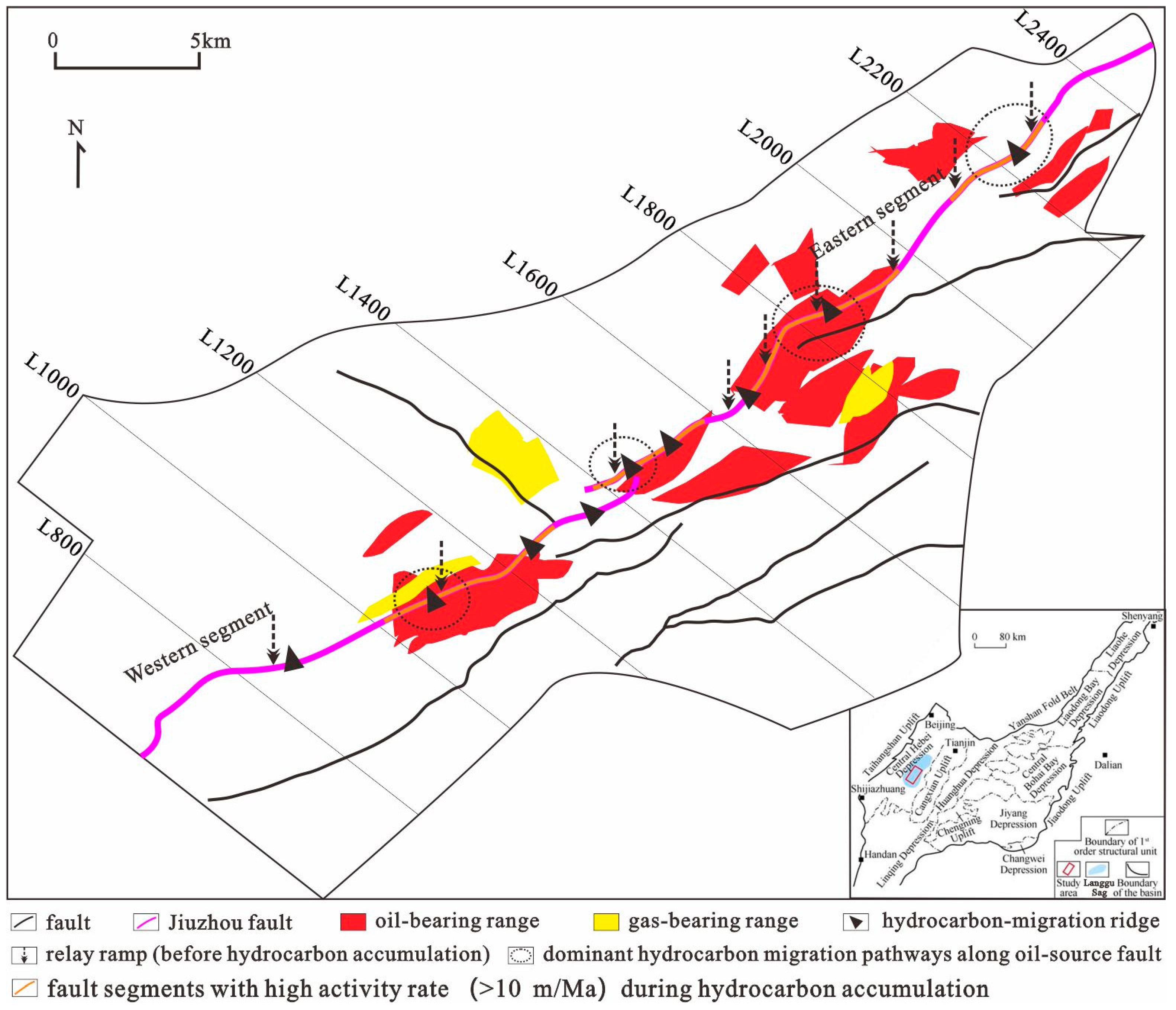
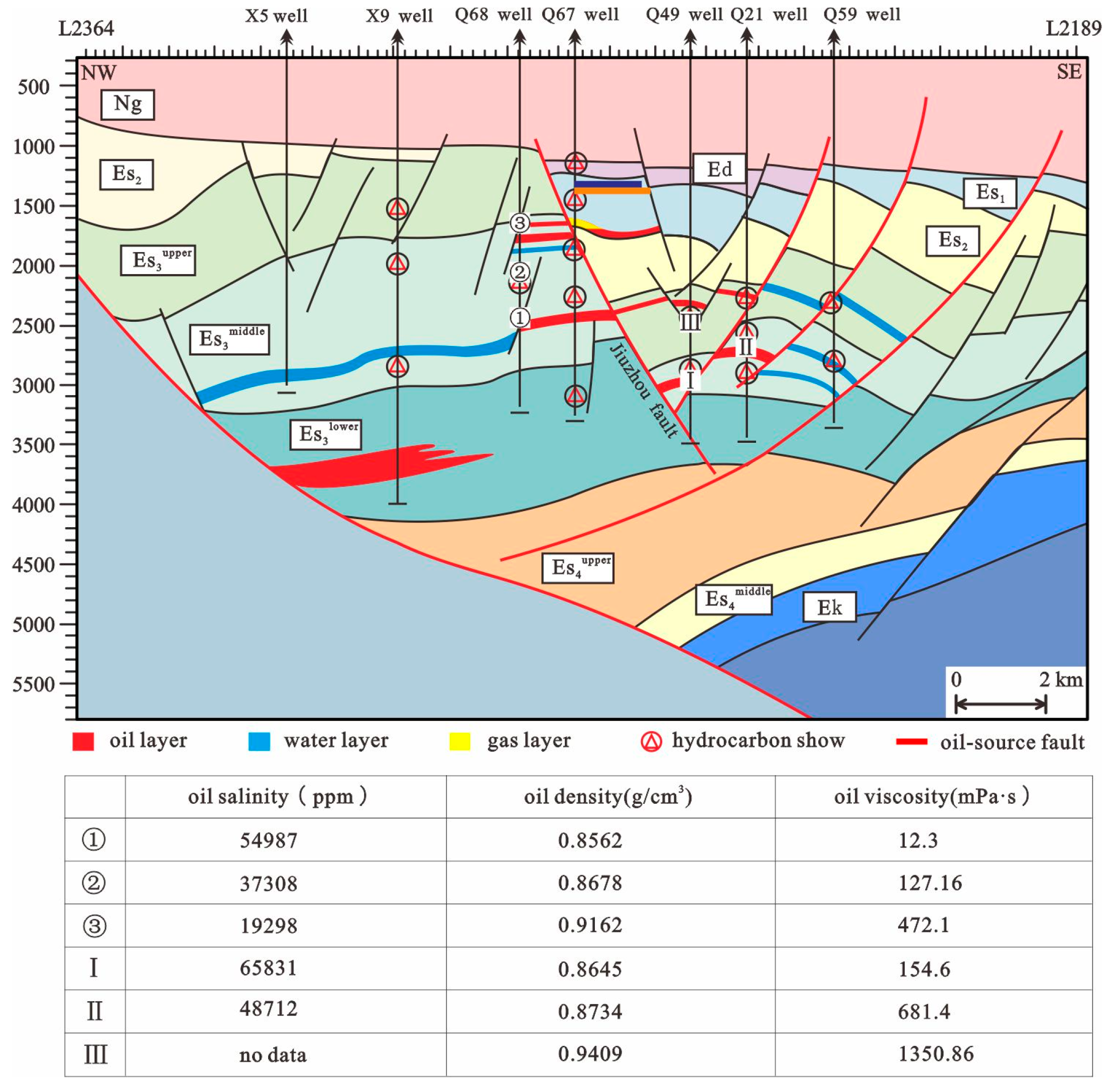
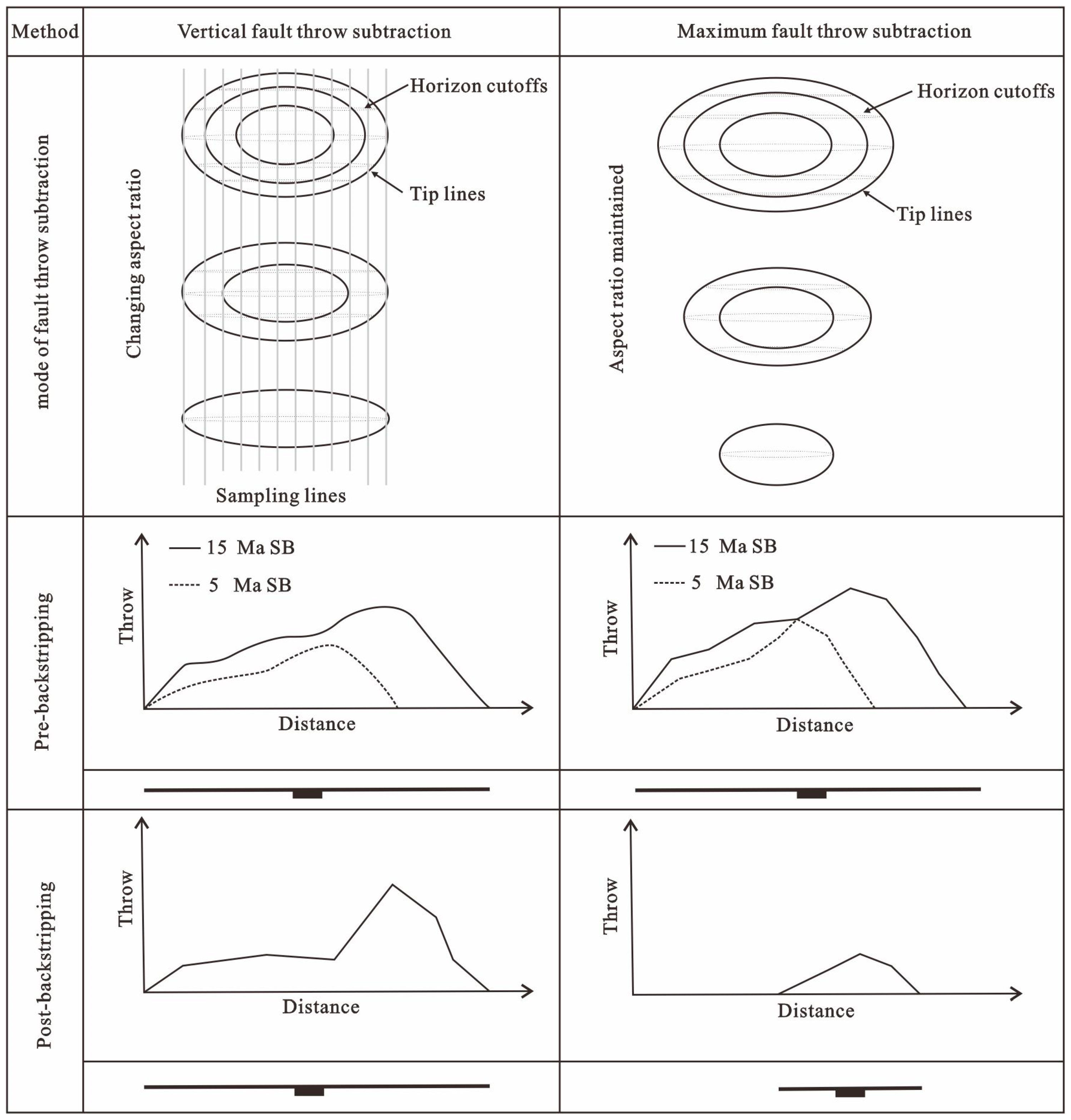

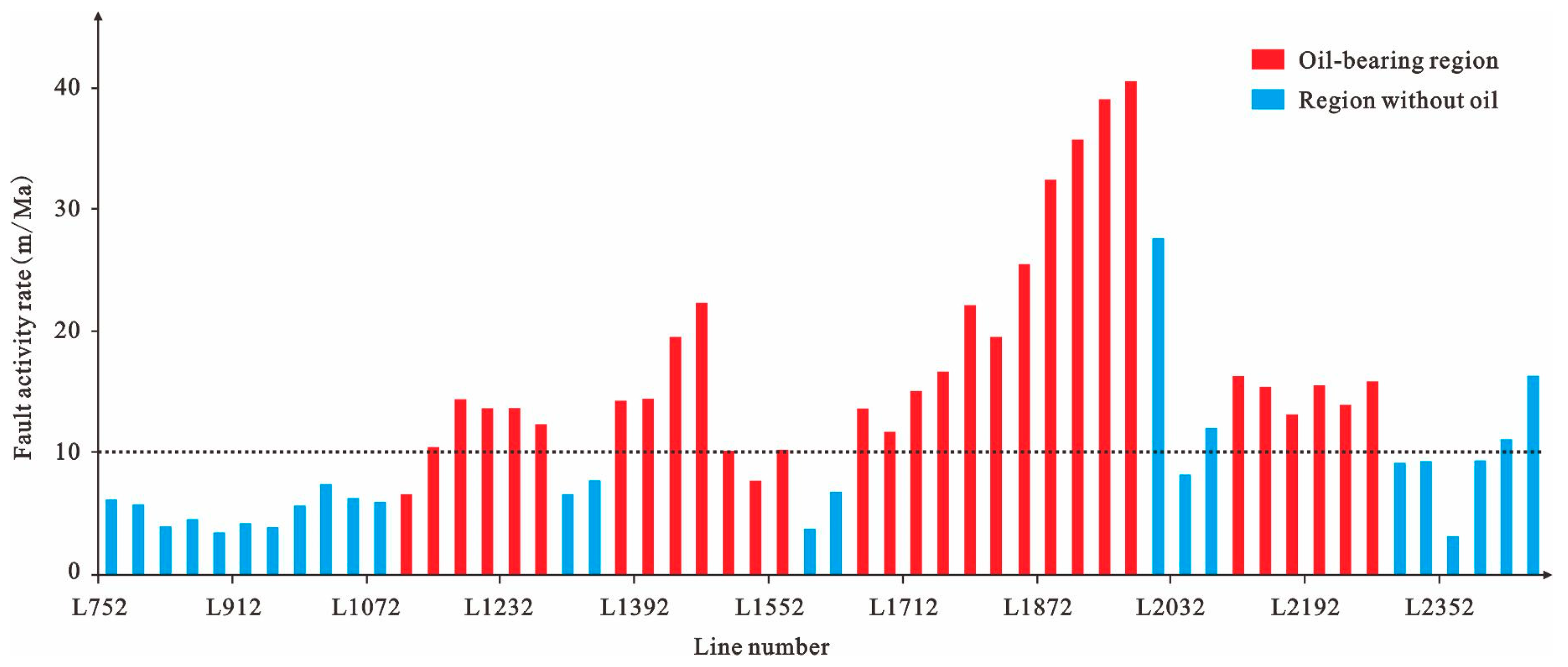
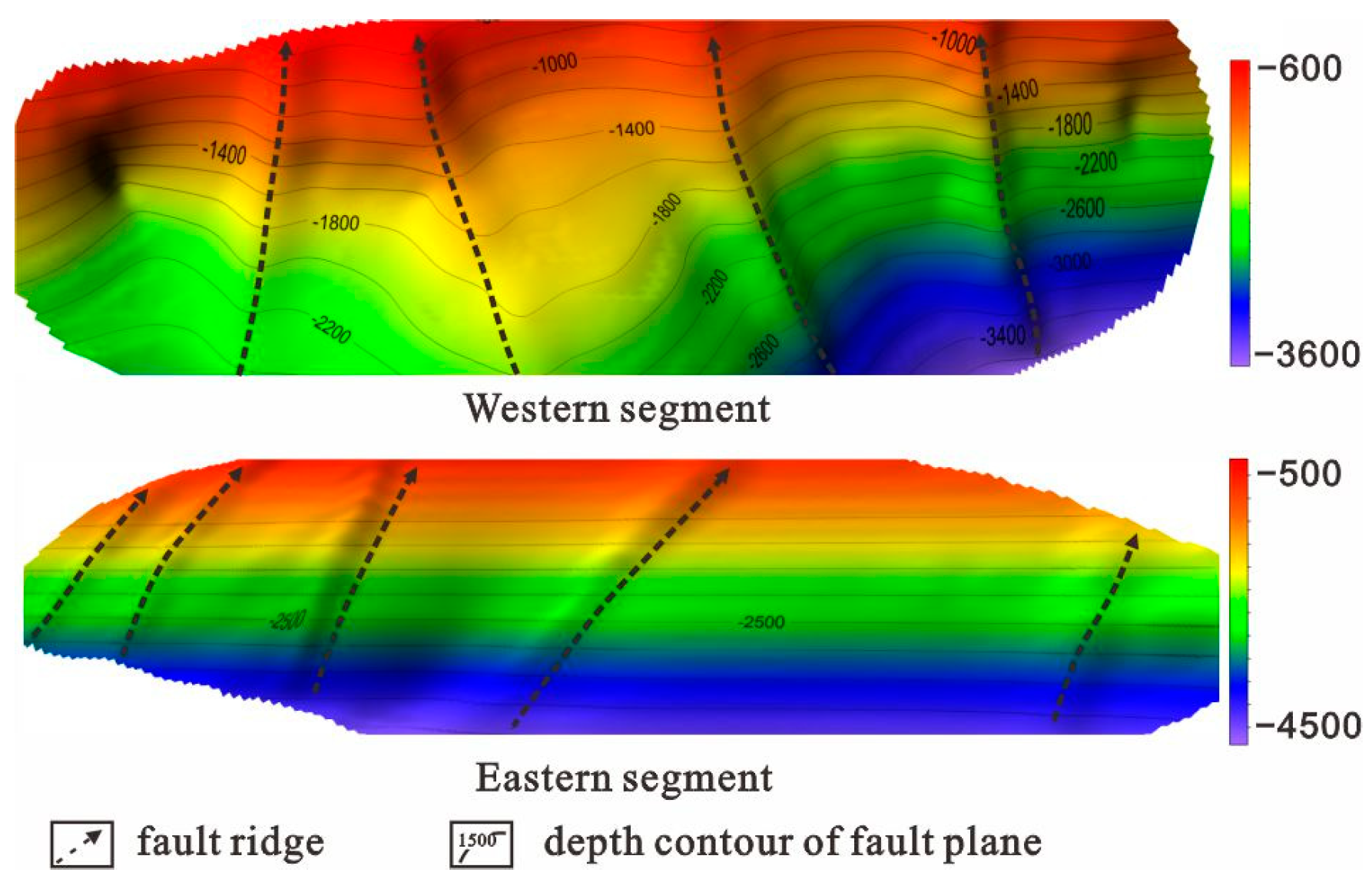
Disclaimer/Publisher’s Note: The statements, opinions and data contained in all publications are solely those of the individual author(s) and contributor(s) and not of MDPI and/or the editor(s). MDPI and/or the editor(s) disclaim responsibility for any injury to people or property resulting from any ideas, methods, instructions or products referred to in the content. |
© 2023 by the authors. Licensee MDPI, Basel, Switzerland. This article is an open access article distributed under the terms and conditions of the Creative Commons Attribution (CC BY) license (https://creativecommons.org/licenses/by/4.0/).
Share and Cite
Liu, J.; Lv, Y.; Wang, Y.; Kang, Y.; Hu, X.; Shi, J. Prediction of Favourable Hydrocarbon Transport Pathways of the Jiuzhou Fault in Langgu Sag, Bohai Bay Basin. Processes 2023, 11, 1666. https://doi.org/10.3390/pr11061666
Liu J, Lv Y, Wang Y, Kang Y, Hu X, Shi J. Prediction of Favourable Hydrocarbon Transport Pathways of the Jiuzhou Fault in Langgu Sag, Bohai Bay Basin. Processes. 2023; 11(6):1666. https://doi.org/10.3390/pr11061666
Chicago/Turabian StyleLiu, Junqiao, Yanfang Lv, Ye Wang, Yunshuang Kang, Xinlei Hu, and Jijian Shi. 2023. "Prediction of Favourable Hydrocarbon Transport Pathways of the Jiuzhou Fault in Langgu Sag, Bohai Bay Basin" Processes 11, no. 6: 1666. https://doi.org/10.3390/pr11061666
APA StyleLiu, J., Lv, Y., Wang, Y., Kang, Y., Hu, X., & Shi, J. (2023). Prediction of Favourable Hydrocarbon Transport Pathways of the Jiuzhou Fault in Langgu Sag, Bohai Bay Basin. Processes, 11(6), 1666. https://doi.org/10.3390/pr11061666









